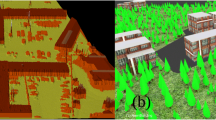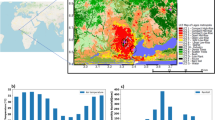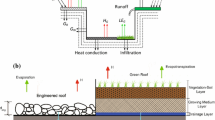Abstract
The 2-way coupled WRF-CMAQ meteorology and air quality modeling system is evaluated for high-resolution applications by comparing to a regional air quality field study (DISCOVER-AQ). The model was modified to better account for the effects of urban environments. High-resolution spatial data for fractions of impervious surfaces and tree canopy from the National Land-Cover Database (NLCD) were processed for each grid and used to scale ground heat capacity and to constrain vegetation coverage and characteristics. These simple algorithms along with modified albedo and roughness length in urban areas result in improved simulation of urban heat island and urban boundary layers. The reduced nocturnal stability and enhanced vertical mixing lead to reduced temperature and humidity biases and reduced under-predictions of ozone concentrations in urban areas.
Access provided by Autonomous University of Puebla. Download conference paper PDF
Similar content being viewed by others
Keywords
These keywords were added by machine and not by the authors. This process is experimental and the keywords may be updated as the learning algorithm improves.
80.1 Introduction
A new modeling system for coupled meteorology and air quality composed of the Weather Research and Forecast (WRF) model [1] and the Community Multiscale Air Quality (CMAQ) model [2] has been recently developed and evaluated for regional and mesoscale applications [3]. The 2-way coupled WRF-CMAQ model has several advantages over traditional sequential meteorology and air quality modeling systems including more frequent data transfer of meteorological information (e.g. winds, temperature, and humidity) to the chemical transport model. As model grid resolution increases, the frequency of data transfer should also increase such that meteorological input is updated more frequently than the typical hourly interval. Another advantage of 2-way coupled systems is the possibility of feedback of chemical information to the meteorological processes that can be affected by gaseous or aerosol species. Currently, direct feedback effects of aerosols on shortwave and long wave radiation is implemented in the WRF-CMAQ system while an experimental implementation of effects of aerosols on CCN activation and cloud microphysics is being evaluated.
80.2 Urban Parametrization
Meteorological and air quality modeling at high-resolutions in urban areas requires consideration of the specific characteristics of urban environments that affect surface energy and moisture budgets, dynamic wind drag, and mechanical turbulence generation. In recent years, urban surface models with three levels of complexity have been added to WRF [4]: a bulk surface scheme, a single-layer model, and a multi-layer model, all of which are coupled to the Noah Land Surface Model (LSM). However, since the coupled WRF-CMAQ system relies on the Pleim-Xiu LSM (PX LSM) [5] for meteorological surface fluxes as well as chemical air-surface exchange (i.e. dry deposition and bi-directional flux) simple urban parameterizations have been added to the PX LSM that leverage the very high resolution (30 m) impervious surface fraction data that are available as part of the National Land Cover Database (NLCD, http://www.mrlc.gov/nlcd06_data.php) to scale surface heat capacity. In addition, albedo and roughness length for the four NLCD urban related land use categories have been revised to better represent developed areas. The NLCD tree canopy coverage data is also used to better account for the effects of urban trees on evapotranspiration and latent heat flux.
80.3 Comparison to Field Studies
A persistent problem in air quality modeling of urban areas is the over-prediction of surface emitted pollutants, such as CO, NOX and primary PM, and under-prediction of O3 during the morning and evening hours. The precise cause of these persistent errors is not known but a prime suspect is an under-prediction of turbulent mixing in the PBL during these transitional times. The neglect of urban surface effects may contribute to these problems since the urban heat island tends to destabilize the lower boundary layer at night and delay the evening transition to downward sensible heat flux. In addition, urban structures induce mechanical turbulence on wind flow through the building canopy.
The simple urban parameterization for the PX LSM, outlined above, is tested for the DISCOVER-AQ field study in July 2011 by running Base and Urban versions of WRF-CMAQ on 4 and 1 km horizontal resolution grids over the Mid-Atlantic region. Figure 80.1 shows the percentage of impervious surface for every grid cell in the 1 km grid resolution model domain as well as the effects of the urban scheme compared to the base case on skin temperature at two times on July 2, 2011. In urban areas with high fractions of impervious surfaces, the skin temperature is warmer at 6 am LT in the Urban run because of slower nighttime cooling due to greater heat capacity, while the Urban run is cooler at 11 am LT because of slower late morning heating.
The urban modifications reduce average 2-m temperature and mixing ratio biases in and around the urban areas (not shown). Consequently, average hourly ozone mixing ratios are higher in the Urban run, mainly in the evening and overnight, because of the deeper and less stable nocturnal boundary layers in the Urban run that better simulates the Urban Heat Island (UHI) effects (Fig. 80.2, top). Figure 80.2 (bottom) also demonstrates that the higher ozone mixing ratios are in better agreement with observations since average bias is reduced for the Urban run in the urban areas.
80.4 Conclusions
A new simple bulk urban parameterization that leverages the highly accurate, high resolution impervious fraction and tree canopy fraction data that are available in the NLCD has been implemented in the PX LSM in the 2-way coupled WRF-CMAQ model system. Model comparisons and evaluation for the DISCOVER-AQ field study show that the Urban scheme improves representation of the UHI effects that lead to reduced biases of 2 m temperature and mixing ratio as well as ozone mixing ratios in urban areas. The effects of the Urban scheme on air quality are most pronounced in the evening when the transition to a stable regime is delayed relative to the Base run resulting in reduced over-predictions of NOx and reduced under-predictions of O3.
Questions and Answers
Questioner name: Steve Hanna
-
Q: Why did you not want to use the WRF-Urban model developed by Fei Chen and colleagues at NCAR?
-
A: The main reason is that the current WRF-Urban options are tied to the Noah land surface model (LSM) and the TKE PBL schemes. We have been developing and using the Pleim-Xiu LSM and the ACM2 non-local closure PBL scheme, neither of which can be used with the Urban options. We not only use these schemes in WRF but also in the air quality part of the system (CMAQ) for PBL mixing, dry deposition, and bi-directional surface fluxes. We are not certain that the simple urban modifications described here are sufficient and plan to continue development and evaluation including inter-comparison with the WRF-Urban models.
Questioner name: Douw Steyn
-
Q: Why iterate only once?
-
A: This question refers to the new iterative technique for data assimilation in the soil temperature and moisture for high-resolution (1–4 km) modeling which was discussed in the presentation but could not be included in this extended abstract due to page limitations. We have tried 2 iterations but saw only minor reductions in error. Thus, in the trade-off between accuracy and run time we don’t feel that multiple iterations are worthwhile. However, we will do more testing.
References
Skamarock WC, Klemp JB, Dudhia J, Gill DO, Barker DM, Duda MG, Huang X-Y, Wang W, Powers JG (2008) A description of the advanced research WRF Version 3, NCAR tech note NCAR/TN 475 STR, 125 pp. Available from: UCAR Communications, P.O. Box 3000, Boulder, CO 80307
Byun D, Schere KL (2006) Review of the governing equations, computational algorithms, and other components of the models-3 community multiscale air quality (CMAQ) modeling system. Appl Mech Rev 59:51–77
Wong DC, Pleim J, Mathur R, Binkowski F, Otte T, Gilliam R, Pouliot G, Xiu A, Young JO, Kang D (2012) WRF-CMAQ two-way coupled system with aerosol feedback: software development and preliminary results. Geosci Model Dev 5:299–312. doi:10.5194/gmd-5-299-2012
Chen F, Miao S, Tewari M, Bao J-W, Kusaka H (2011) A numerical study of interactions between surface forcing and sea breeze circulations and their effects on stagnation in the greater Houston area. J Geophys Res 116:D12105. doi:10.1029/2010JD015533
Pleim JE, Xiu A (1995) Development and testing of a surface flux and planetary boundary layer model for application in mesoscale models. J Appl Meteorol 34:16–32
Author information
Authors and Affiliations
Corresponding author
Editor information
Editors and Affiliations
Rights and permissions
Copyright information
© 2014 Springer International Publishing Switzerland
About this paper
Cite this paper
Pleim, J. et al. (2014). Application and Evaluation of High-Resolution WRF-CMAQ with Simple Urban Parameterization. In: Steyn, D., Mathur, R. (eds) Air Pollution Modeling and its Application XXIII. Springer Proceedings in Complexity. Springer, Cham. https://doi.org/10.1007/978-3-319-04379-1_80
Download citation
DOI: https://doi.org/10.1007/978-3-319-04379-1_80
Published:
Publisher Name: Springer, Cham
Print ISBN: 978-3-319-04378-4
Online ISBN: 978-3-319-04379-1
eBook Packages: Earth and Environmental ScienceEarth and Environmental Science (R0)






